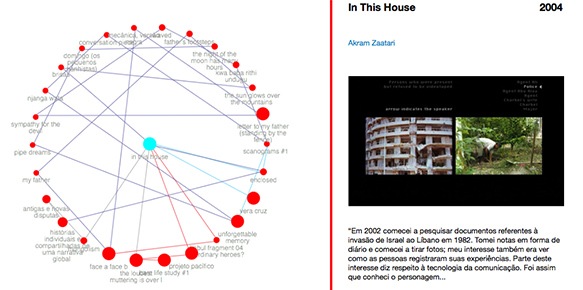Akram Zaatari
Tackling issues such as the power of media, the validity of national and religious foundations and their imposition on morals and sexuality, Akram Zaatari’s videos and video installations keep tabs on the changes undergone by Lebanese society and culture during the post-civil war period (1990 onwards). In the film Akram Zaatari – A Glimpse of One Man’s Vision, from the Videobrasil Authors Collection, Zaatari remarks that the war prompted him to take his first pictures: photographs of a building before and after a shelling, in 1982.
Akram Zaatari is featured in Unerasable Memories with In This House (2004), a video that has been part of the Videobrasil Collection since 2005. In an interview given on occasion of the launch of Akram Zaatari – A Glimpse of One Man’s Vision, Zaatari states the piece is about the “archaeology of invasions.”
The piece features two simultaneous screens and has the artist literally dig up the past for a letter written and buried in 1991 by the photojournalist Ali Hashisho. Hashisho joined the Lebanese resistance on occasion of the Israeli army’s siege and shelling of Beirut, in 1982, purportedly to drive out the Palestinian Liberation Organization from Lebanon. According to a statement from the artist available on PLATFORM:VB, during this period, Israel invaded and evacuated the village of Ain el Mir – where In This House takes place –, which was considered a strategic position. Empty houses were later occupied by Lebanese and Palestinian guerrillas – among them Ali Hashisho.
Excerpt from the Videobrasil Authors Collection documentary A Glimpse of One Man’s Vision
As a result of the Charter of National Reconciliation (Taef Agreement), signed in 1989, popular resistance was disarmed. Families were able to return to their homes in the years that followed. Ali Hashisho stored the letter to the house’s owners in an empty bomb casing and buried it in the garden. His goal was to tell how he and his mates looked after the house and give thanks for the shelter it provided.
Manuel Segade, the curator who wrote about Akram Zaatari’s work for the Unerasable Memories book, rates In This House as one of the “most significant pieces in grasping the complexity of the artist’s (...) narrative strategies.” Even though Akram Zaatari allows himself to introduce imaginary elements in some of his videos, In This House is a factual piece. The question of fiction versus reality can be raised nonetheless, since Zaatari describes the story told by Hashisho as unbelievable. “As they dug, I had my misgivings about whether Hashisho was misleading me,” he concedes in an interview to newspaper Folha de São Paulo, in 2005.
Closely connected with Videobrasil’s internationalization process, Akram Zaatari took part in the Festival for the first time in 1996, a time when filmmaking in Lebanon was a challenge in financial, political and bureaucratic terms, as he says in a statement available on VB Channel. He has featured in eight different editions of the Festival; as a result, Lebanon became a mainstay at the event, and now his oeuvre is significantly present in the Videobrasil Collection, which includes 11 of his video pieces. Alongside Christine Tohme, he curated the show Possible Narratives – Artistic Practices in Lebanon during the 14thFestival. The show featured the works of nine Lebanese artists, among them Walid Raad, who also participates in Unerasable Memories.
One of the most widely acknowledged Lebanese contemporary artists, Zaatari is the co-founder of the Arab Image Foundation, whose mission is to preserve the photographic memory of the Middle East, North Africa and the Arab Diaspora. Akram Zaatari represented Lebanon at the 55th Venice Biennale (2013) and his work is owned by institutions, such as Tate Gallery (London, United Kingdom), the Museum of Modern Art (New York, USA), Centre Georges Pompidou (Paris, France) and the Thyssen-Bornemisza Art Contemporary (Vienna, Austria).
Learn more about the artist:


